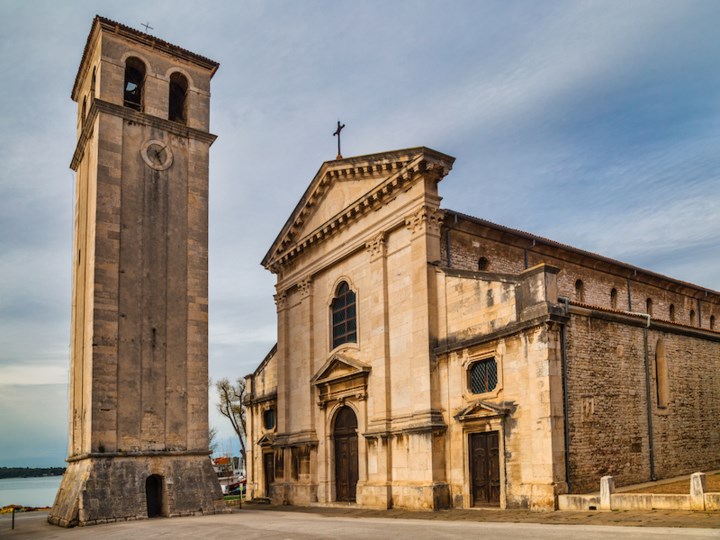The city located on the Istrian peninsula, also known as
"little Rome", adorns this region with its magnificent history. Pula,
the largest city in Istria, amazes with its beauty, and at the same time represents the tourist and economic centre of Istria.
The very thought of the city of Pula, takes us back to the
ancient Roman times and gladiator battles. This Istrian city
resembles the city of Rome precisely because of its architecture and the famous Pula Arena. So let’s start from this historic city's very beginning. The city of Pula was
founded on the hill named Kastel more than 3000 years ago, originally as the
fortress Histra, which, under the influence of the Romans, later became a city called
"Colonia Pietas Iulia Pola".
Given its favourable location, Pula was already at that time developing as
one of the most important transit connections on the Adriatic coast. Precisely because of its
connection with Italy, it is visible that the cities of
Venice and Rome were one of the
main factors influencing the development and architectural style of this magnificent city. It was these two cities that influenced Pula to have some of the most beautiful ancient
monumental structures such as:
the Pula Arena, the Temple of Augustus and the Arch of Sergius.

The building for which this city is world famous is its
Amphitheater. It is the
largest preserved monument of Roman architecture in Croatia, where gladiator fights, various
musical and theatrical performances took place and where citizens spent their free time. The amphitheater in Pula ranks
6th in size among amphitheaters in the world and is
the only one in the world whose all three Roman architectural orders are fully preserved.
This monumental building was
built during the 1st century, and legends say that it was
built by the Emperor Vespasian in honour of his mistress Antonia Cenida, who lived in Pula. This historical building is open to visitors for sightseeing, so if you want to see a glimpse of Roman history, be sure to walk through the Pula Arena. You can even
stand in the tunnels and corridors where the warriors and lions stood before the fight and feel the adrenaline before entering the auditorium.
 One of the main streets in Pula “Ulica Sergijevaca”
One of the main streets in Pula “Ulica Sergijevaca”, named after the
Sergii family who built their empire in Pula, can be seen through the
triumphal arch of the Sergijevci. This monument is
located at the beginning of this street, also known as
Via Sergia or Corso, and will lead you to the
Pula Forum. This
street leads us to the next monument of this city,
the Temple of Augustus. This well preserved Roman temple is located in the central town square. It was named after the first Roman
emperor Augustus.
The
Forum is a pedestrian zone only, with various cafes and restaurants. Speaking of promenades, every city that was under the influence of the Romans, including Pula, is recognisable by its stone walls. Once used as defensive walls, today's walls in Pula are an ideal place for walks, whose paths lead to the city centre.

And now let’s move on to the more
modern editions of this inviting city. Near the Pula Arena, the
Uljanik Shipyard is located with
cranes also known as the Glowing Giants. What makes them special is the
light show that happens when it gets dark. You can enjoy this beautiful light spectacle every night. The glowing giants are a creation of designer Dean Skira, who brought the cranes to life with vibrant colours, which come in more than 16,000 combinations.

We recommend you to
browse the Pula City Market, located in a
beautiful historic building with special architecture. Unlike the markets in the rest of Croatia, which are mostly of the external type, the market in Pula resembles the Great Market in Budapest, but is much smaller. Here you will find fresh fish, meat as well as fresh vegetables, fruit, homemade honey, olive oil and wine at the outdoor stalls.
The city of Pula has an
amazingly large stage of events throughout the summer. This city does not only have a beautiful centre. Many will go further south, out of town, towards
Verudela and Medulin for even more content. If we head towards
Verudela we can find
beautiful stone beaches known as Golden Rocks, precisely because of their specific warm colours, which are an ideal place to enjoy by the crystal clear sea. Along the way you may come across places with old villas built during the Austro-Hungarian period.

Speaking of content,
Pula certainly offers something for everyone. Starting from the
Adrenaline Park Pula, where you can find activities for all ages, the
Pula Aquarium to the Varudela Canyon, for all those who want to explore the nature of this stone peninsula. We are sure you will find something for yourself and your family in this magnificent city.
Kristina Nikesic
04.11.2021

 MY ISTRIA GUIDE
MY ISTRIA GUIDE





